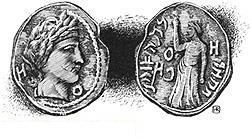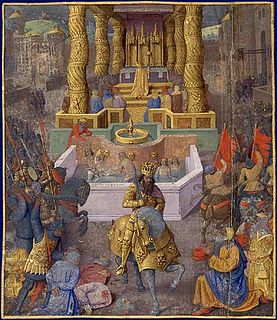Related Research Articles

Alexander Jannaeus was the second king of the Hasmonean dynasty, who ruled over an expanding kingdom of Judea from 103 to 76 BCE. A son of John Hyrcanus, he inherited the throne from his brother Aristobulus I, and married his brother's widow, Queen Salome Alexandra. From his conquests to expand the kingdom to a bloody civil war, Alexander's reign has been generalised as cruel and oppressive with never-ending conflict. The major historical sources of Alexander's life are Josephus's Antiquities of the Jews and The Jewish War.

Herod I, also known as Herod the Great, was a Roman client king of Judea, referred to as the Herodian kingdom. He is known for his colossal building projects throughout Judea, including his renovation of the Second Temple in Jerusalem and the expansion of the Temple Mount towards its north, the enclosure around the Cave of the Patriarchs in Hebron, the construction of the port at Caesarea Maritima, the fortress at Masada, and Herodium. Vital details of his life are recorded in the works of the 1st century CE Roman–Jewish historian Josephus.

Cleopatra I Syra was a princess of the Seleucid Empire, Queen of Ptolemaic Egypt by marriage to Ptolemy V of Egypt, and regent of Egypt during the minority of their son, Ptolemy VI, from her husband’s death in 180 BC until her own death in 176 BC.

Antiochus XII Dionysus Epiphanes Philopator Callinicus was a Hellenistic Seleucid monarch who reigned as King of Syria between 87 and 82 BC. The youngest son of Antiochus VIII and, most likely, his Egyptian wife Tryphaena, Antiochus XII lived during a period of civil war between his father and his uncle Antiochus IX, which ended with the assassination of Antiochus VIII in 96 BC. Antiochus XII's four brothers laid claim to the throne, eliminated Antiochus IX as a claimant, and waged war against his heir Antiochus X.

The Hasmonean dynasty was a ruling dynasty of Judea and surrounding regions during classical antiquity, from c. 140 BCE to 37 BCE. Between c. 140 and c. 116 BCE the dynasty ruled Judea semi-autonomously from the Seleucid Empire, and from roughly 110 BCE, with the empire disintegrating, Judea gained further autonomy and expanded into the neighboring regions of Samaria, Galilee, Iturea, Perea, and Idumea. The Hasmonean rulers took the Greek title "basileus",, and some modern scholars refer to this period as an independent kingdom of Israel. The kingdom was ultimately conquered by the Roman Republic and the dynasty was displaced by Herod the Great in 37 BCE.

The Nabataeans, also Nabateans, were an ancient Arab people who inhabited northern Arabia and the southern Levant. Their settlements—most prominently the assumed capital city of Raqmu —gave the name Nabatene to the Arabian borderland that stretched from the Euphrates to the Red Sea.
Antipater I the Idumaean was the founder of the Herodian Dynasty and father of Herod the Great. According to Josephus, he was the son of Antipas and had formerly held that name.

Judaea was a Roman province which incorporated the regions of Judea, Samaria and Idumea, and extended over parts of the former regions of the Hasmonean and Herodian kingdoms of Judea. It was named after Herod Archelaus's Tetrarchy of Judaea, but the Roman province encompassed a much larger territory. The name "Judaea" was derived from the Kingdom of Judah of the 6th century BCE.

John Hyrcanus II, a member of the Hasmonean dynasty, was for a long time the Jewish High Priest in the 1st century BCE. He was also briefly King of Judea 67–66 BCE and then the ethnarch (ruler) of Judea, probably over the period 47–40 BCE.

Aretas IV Philopatris was the King of the Nabataeans from roughly 9 BC to AD 40.

Gaius Sosius was a Roman general and politician who featured in the wars of the late Republic as a staunch supporter of Mark Antony. He held several important state offices and military commands in Antony's service, and led the military expedition to install Rome's client, Herod, as king of Judea. Sosius became consul in the critical year 32 BC, when the Second Triumvirate lapsed and open conflict erupted between the triumvirs, Antony and Octavian. As consul, Sosius warmly espoused the cause of Antony and vigorously opposed Octavian in the Senate, for which he was forced to flee Rome.
Quintus Didius was a Roman governor of the province Syria.
Quintus Dellius was a Roman commander and politician in the second half of the 1st century BC. His family was of equestrian rank in the Roman social system of status.
Costobarus was an associate of Herod the Great and second husband of Herod's sister Salome I. He was also known as Costobar.
Marcus Titius was a Roman politician and commander at the end of the Roman Republic.
Cleopatra of Jerusalem was a woman who lived in the 1st century BC during the Roman Empire. She was the fifth wife of King of Judea Herod the Great.
The Gabiniani were 2000 Roman legionaries and 500 cavalrymen stationed in Egypt by the Roman general Aulus Gabinius after he had reinstated the Pharaoh Ptolemy XII Auletes on the Egyptian throne in 55 BC. The soldiers were left to protect the King, but they soon adopted the manners of their new country and became completely alienated from the Roman Republic. After the death of Auletes in 51 BC, they helped his son Ptolemy XIII in his power struggle against his sister Cleopatra and even involved Julius Caesar, the supporter of Cleopatra, during Caesar's Civil War up to the siege of Alexandria in violent battles.
Serapion was strategos of Cyprus and admiral of the Ptolemaic navy during the reign of Cleopatra VII in 43 BC. Against the intention of the Egyptian queen he supported in the Roman civil war Gaius Cassius Longinus, but had to take refuge in Tyre and was finally handed over to Cleopatra in 41 BC. Perhaps he is identical with that Serapion, who was instructed by Julius Caesar to negotiate in 48 BC with the Egyptian commander Achillas.

Herod the Great's siege of Jerusalem was the final step in his campaign to secure the throne of Judea. Aided by Roman forces provided by Marcus Antonius, Herod was able to capture the city and depose Antigonus II Mattathias, ending Hasmonean rule. The siege appears in the writings of Josephus and Dio Cassius.
Seleucus was in 30 BC a commandant of the eastern Egyptian border-fortress Pelusium.
References
- Ulrich Wilcken: Athenion 5. In: Realencyclopädie der Classischen Altertumswissenschaft , vol. II, 2 (1896), col. 2039.
- Michael Grant: Kleopatra. Biographie (= Bastei-Lübbe-Taschenbuch. Bd. 61416). Lübbe, Bergisch Gladbach 1998, ISBN 3-404-61416-X, p. 271.
- Christoph Schäfer: Kleopatra. Wissenschaftliche Buchgesellschaft, Darmstadt 2006, ISBN 3-534-15418-5, p. 200-201.